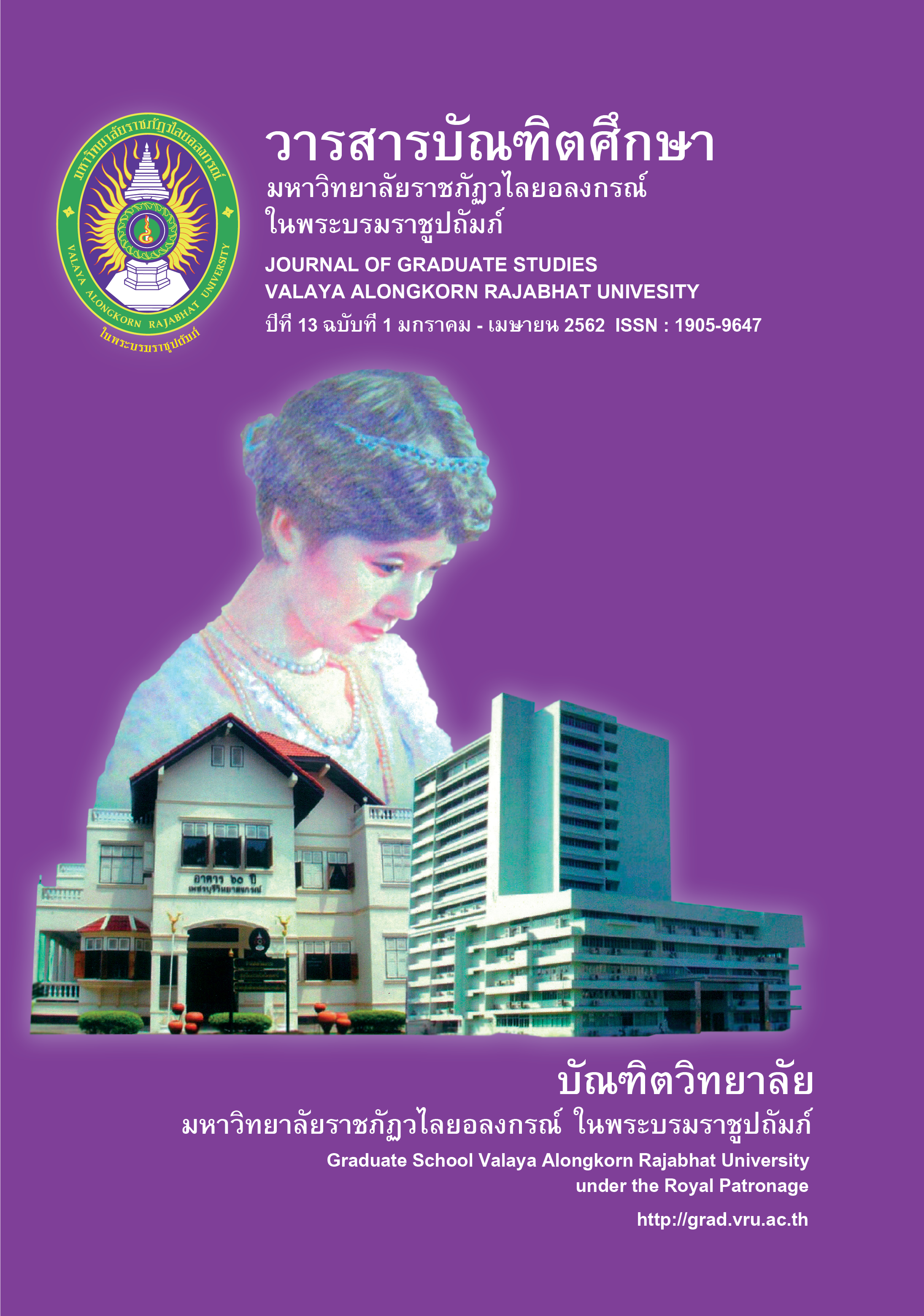ความเป็นไปได้ในการประยุกต์ใช้การสอนเชิงรุกอาคีตะโมเดลในประเทศไทย
Main Article Content
บทคัดย่อ
การวิจัยครั้งนี้มีวัตถุประสงค์ 3 ประการ คือ 1) เพื่อวิเคราะห์สังเคราะห์ที่มา ขั้นตอนการดำเนินงานเกี่ยวกับอาคีตะโมเดล 2) ศึกษากระบวนการวิธีการและการดำเนินงานของอาคีตะโมเดล
3) วิเคราะห์สภาพแวดล้อมและคาดการณ์ความสำเร็จที่จะนำมาใช้ในประเทศไทย 4) ประมวล วิเคราะห์ สังเคราะห์กระบวนการเพื่อพัฒนาองค์ความรู้ ในส่วนวิธีการวิจัย ดำเนินการวิจัยโดยการศึกษาดูงาน สัมภาษณ์พูดคุย ทำการทดลองและจัดสนทนากลุ่ม กลุ่มตัวอย่าง ประกอบด้วยนักการศึกษา ครู ผู้ปกครอง/ประชาชนและนักเรียนของประเทศไทยและจังหวัดอาคีตะ
ผลการศึกษาพบว่า อาคีตะโมเดลมีจุดมุ่งหมาย คือ การค้นพบปัญหาด้วยตนเอง สามารถสื่อสาร มีปฏิสัมพันธ์เพื่อแก้ปัญหาด้วยตนเองได้ ประกอบด้วย 4 ขั้นตอน ดังนี้ 1) ตั้งข้อสังเกตในการเรียนรู้ 2) มีความคิดของตนเอง 3) อภิปรายกันเป็นคู่/กลุ่ม/ชั้นเรียน 4) ทบทวนเนื้อหาและวิธีการเรียนรู้ การนำอาคีตะโมเดลมาใช้ ครูไทยต้องปรับทัศนคติในการสอน ต้องให้เด็กดำเนินกระบวนการเรียนรู้ในชั้นเรียนแทนครู ครูไทยต้องปรับบทบาท ต้องทำให้เด็กอยากรู้ด้วยตนเอง ต้องตั้งเป้าหมายให้ชัดว่า อะไรคือสิ่งที่ต้องการให้เด็กรู้ อยากให้แก้โจทย์ อยากให้รู้จัก ครูควรกำหนดล่วงหน้า ว่าส่วนไหนครูสอน ส่วนไหนให้เด็กอภิปรายแลกเปลี่ยนกันเอง สร้างลักษณะนิสัยให้นักเรียนฝึกคิดเอง เป็นสำคัญ ต้องสามารถสื่อสารกับคนอื่นให้เข้าใจด้วย จุดสำคัญคือการรอ ให้เวลาเด็กคิด ครูต้องรอไม่รีบเฉลย
การรับแนวคิดอาคีตะโมเดลมาปรับใช้ในประเทศไทยมีข้อควรตระหนักและพึงระวัง คือ การปรับเปลี่ยนแนวคิดแนวปฏิบัติเดิม ๆ เพื่อไปสู่วัฒนธรรมคุณภาพแบบญี่ปุ่น ซึ่งเป็นเรื่องค่อนข้างยาก แต่หากได้ลงมือทำทุกวิชา ทุกวัน ทุกเวลา และทุกชั้นเรียนอย่างต่อเนื่อง 2-3 ปี ความเปลี่ยนแปลงย่อมจะเกิดขึ้นได้อย่างยั่งยืน หลักคิดสำคัญที่ได้จากการวิจัยครั้งนี้ คือ 1) ต้องรู้จักโครงการให้ละเอียด 2) เรียนรู้และทำความเข้าใจกับสภาพจริง 3) ทำไปประเมินไป 4) เข้าใจบริบทวัฒนธรรมกระบวนการหลัก และ 5 กระบวนการได้อย่างเหมาะสม 5) Lesson Study เป็นหัวใจของการดำเนินส่วนวิธีการรับแนวคิดมี 6 ขั้นตอนใหญ่ คือ 1) เรียนรู้จากการมาเยือน เตือนใจให้คิด 2) สื่อสารสร้างสัมพันธ์กระชับมิตร 3) ร่วมจิตลองทำ นำไปปฏิบัติ 4) เรียนรู้ชัดจากของจริง 5) ประเมินทุกสิ่งจากประสบการณ์ และ 6) อย่าฝันหวานเกินไป
การปรับวัฒนธรรมของเราให้ได้ตามแบบขอญี่ปุ่นเป็นสิ่งที่เป็นไปได้โดยยาก ทางออกที่ดีน่าจะอยู่ที่ว่าเราต้องสังเกตและวิเคราะห์ออกมาให้ได้ ว่าหัวใจของสิ่งที่จะนำเข้ามาปรับใช้ คือ อะไร และปรับให้เป็นมโนทัศน์ที่เข้าใจง่าย เพื่อปรับและดำเนินการในวัฒนธรรมของเรา โดยไม่เสียหลักการของเดิมของเขา
Article Details
บทความทุกเรื่องได้รับการตรวจความถูกต้องทางวิชาการโดยผู้ทรงคุณวุฒิ ทรรศนะและข้อคิดเห็นในบทความวารสารบัณฑิตศึกษา มหาวิทยาลัยราชภัฏวไลยอลงกรณ์ ในพระบรมราชูปถัมภ์ มิใช่เป็นทรรศนะและความคิดของผู้จัดทำจึงมิใช่ความรับผิดชอบของบัณฑิตวิทยาลัย มหาวิทยาลัยราชภัฏวไลยอลงกรณ์ ในพระบรมราชูปถัมภ์ กองบรรณาธิการไม่สงวนสิทธิ์การคัดลอก แต่ให้อ้างอิงแหล่งที่มา
เอกสารอ้างอิง
Sinlarat, P. (2006). kānsưksā chœ̄ng sāngsan læ phalit phāp [Creative and productive education]. Bangkok: Chulalongkorn University Printing House.
Sinlarat, P. (2010a). phū nam chœ̄ng sāngsan læ phalit phāp [Creative productive leader]. Bangkok: Chulalongkorn University Printing House.
Sinlarat, P. (Ed.). (2010b). CCPR krō̜p khit mai thāngkān sưksā [CCPR new educational framework for implementing]. Bangkok: Chulalongkorn University Printing House.


